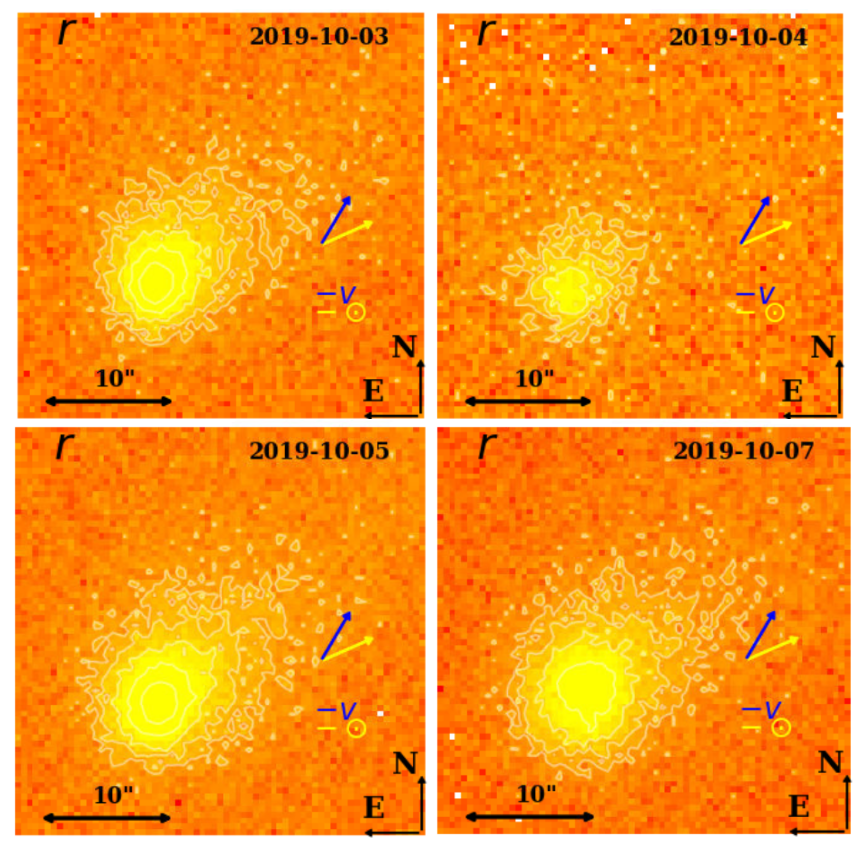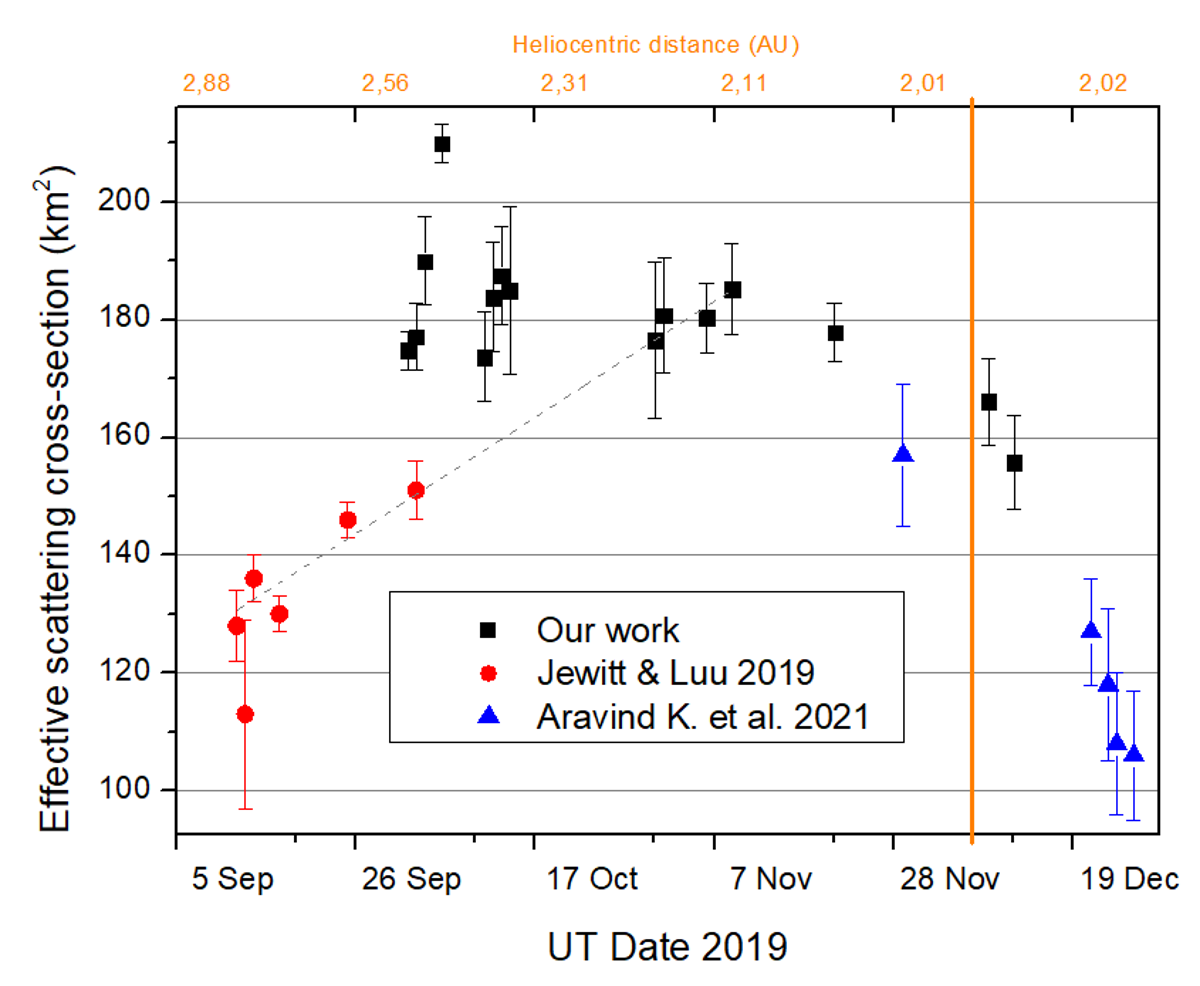- 1Faculty of Physics, University of Bucharest, 405 Atomiștilor str., Măgurele 077125, Ilfov, Romania
- 2Astronomical Institute of the Romanian Academy, 5 Cuțitul de Argint, 040557 Bucharest, Romania
- 3Instituto de Astrofísica de Canarias (IAC), C/Vía Láctea s/n, E-38205, La Laguna, Spain
- 4Departamento de Astrofísica (ULL), E-38205, La Laguna, Spain
- 5University of Tokyo, Tokyo, Japan
- 6Institute of Space Science, Atomiștilor 409, 077125, Bucharest-Măgurele, Romania
- 7Isaac Newton Group of Telescopes (ING), Apto. 321, E-38700 Santa Cruz de la Palma, Canary Islands, Spain
- 8Faculty of Sciences, University of Craiova, Craiova, Romania
- 9Astrobiology Ctr. and Japan Science and Technology Agency (Japan)
Comets are primitive objects which formed in the outer parts of the proto-planetary disk, beyond the snow line. They can provide key information about the origins of our Solar System and its primordial nebula. The latest interstellar visitor [1], comet 2I/Borisov (initially designated C/2019 Q4), has given us the chance to have a probe from this environment of an unknown star and to explore the possibility of exchanging material between different planetary systems.
We took advantage of this opportunity by performing an extended observational program over two months and a half time interval, between October 3 and December 13, 2019. We obtained observations of 2I/Borisov with the 1.52m Telescopio Carlos Sánchez located on Teide Observatory, Tenerife, Spain. This telescope is equipped with MuSCAT2 instrument [2] which allows to obtain spectrophotometric data in four optical filters (g, r, i, z_s). The images are acquired simultaneously thanks to a dichroic mirrors system. Thus, we gather data on 26 observational nights, for about one hour of observations on each night. During this time which corresponds mainly before the perihelion passage of this comet, 2I/Borisov was visible before the morning twilight.
We used the Photometry Pipeline (PP) software [3] and several Python scripts in order to calibrate the images. We used the NoiseChisel tool, included in the Gnuastro package [4] to detect the faint structure of the 2I/Borisov coma. Here we report the preliminary results corresponding to 15 nights of observations on which the comet didn't overlapped with a background source.
First, we determined the optical colors by considering a fixed linear aperture (of 15000 km, which in angular distance is equivalent of 8.3 - 10.3 arcseconds, depending on the distance Earth-comet). We found the average values of g-r = 0.67 +/- 0.06; r-i = 0.20 +/-0.07, and i-z_s = 0.14 +/- 0.07. Within the error bars, these values remained constant over all the observed period. These values are similar with those of Solar System long-period comets and of Trans-Neptunian objects [5].
Second, for each observing set we studied the morphology of the coma. This allows us to identify two outbursts at the beginning of October, 2019 when the comet was at a heliocentric distance of 2.47 - 2.46 A.U. Fig. 1 shows four images obtained with r filter during that time. The morphology is consistent in each band we investigated.
Last but no least, we computed the effective scattering cross-section. The results are shown in Fig. 2, and highlights the minor outburst from the beginning of October, 2019. These findings are compared to other results which obtained data around our observing time interval [6, 7]. A further step in this analysis is to compute the dust production rate and the total mass loss. The dust model takes into account the size distribution of particles and the scattering efficiency of the cross-sections.
Fig. 1 The stacked images for the comet 2I/Borisov, obtained during the beginning of October 2019. The black arrows show the right ascension and the declination direction. The blue and the yellow arrows show the anti-velocity and anti-solar vectors.

Fig. 2 Effective scattering cross-section as a function of time. The heliocentric distance is also shown.

References
[1] de León, Julia et al.; MNRAS, Volume 495, Issue 2, pp.2053-2062, (2020).
[2] Narita, Norio et al.; Journal of Astronomical Telescopes, Instruments, and Systems, Volume 5, id. 015001 (2019).
[3] Mommert, Michael; Astronomy and Computing, Volume 18, p. 47-53 (2017).
[4] Akhlaghi, Mohammad; Ichikawa, Takashi; The Astrophysical Journal Supplement Series, Volume 220, Issue 1, article id. 1, 33 pp. (2015).
[5] Solontoi, Michael; Icarus, Volume 205, Issue 2, p. 605-618 (2010)
[6] Jewitt, David; Luu, Jane; The Astrophysical Journal Letters, Volume 886, Issue 2, article id. L29, 6 pp. (2019).
[7] Aravind, K. et al., Monthly Notices of the Royal Astronomical Society, Volume 502, Issue 3, pp.3491-3499 (2021)
How to cite: Prodan, G. P., Popescu, M., Licandro, J., Akhlaghi, M., de León, J., Tatsumi, E., Păstrav, B. A., Hibbert, J. M., Văduvescu, O., Simion, G. N., Pallé, E., Narita, N., and Murgas, F.: Spectrophotometric characterization of interstellar comet 2I/Borisov before perihelion passage, Europlanet Science Congress 2021, online, 13–24 Sep 2021, EPSC2021-477, https://doi.org/10.5194/epsc2021-477, 2021.

